Taxation Law Assignment: Income Tax and Capital Gains Tax Analysis
VerifiedAdded on 2021/05/31
|10
|2037
|19
Homework Assignment
AI Summary
This taxation law assignment presents a detailed analysis of various tax implications. The assignment addresses key issues, including the tax consequences of income derived from personal exertion, such as payments received for media interviews and the sale of literary rights. It explores relevant legislation, specifically referencing the ITAA 1997 and case law such as Scott v CT and Brent v F.C of T, to determine the taxability of income. Furthermore, the assignment examines the tax implications of interest received on loans and capital gains tax (CGT) related to the sale of property, including pre-CGT and post-CGT assets. The analysis incorporates specific scenarios, such as a mountain climber's income and a parent-child loan, to illustrate the application of tax principles. The document provides detailed answers to specific questions, incorporating legal principles and case precedents to support its conclusions. The document also includes a comprehensive reference list of sources used in the analysis.
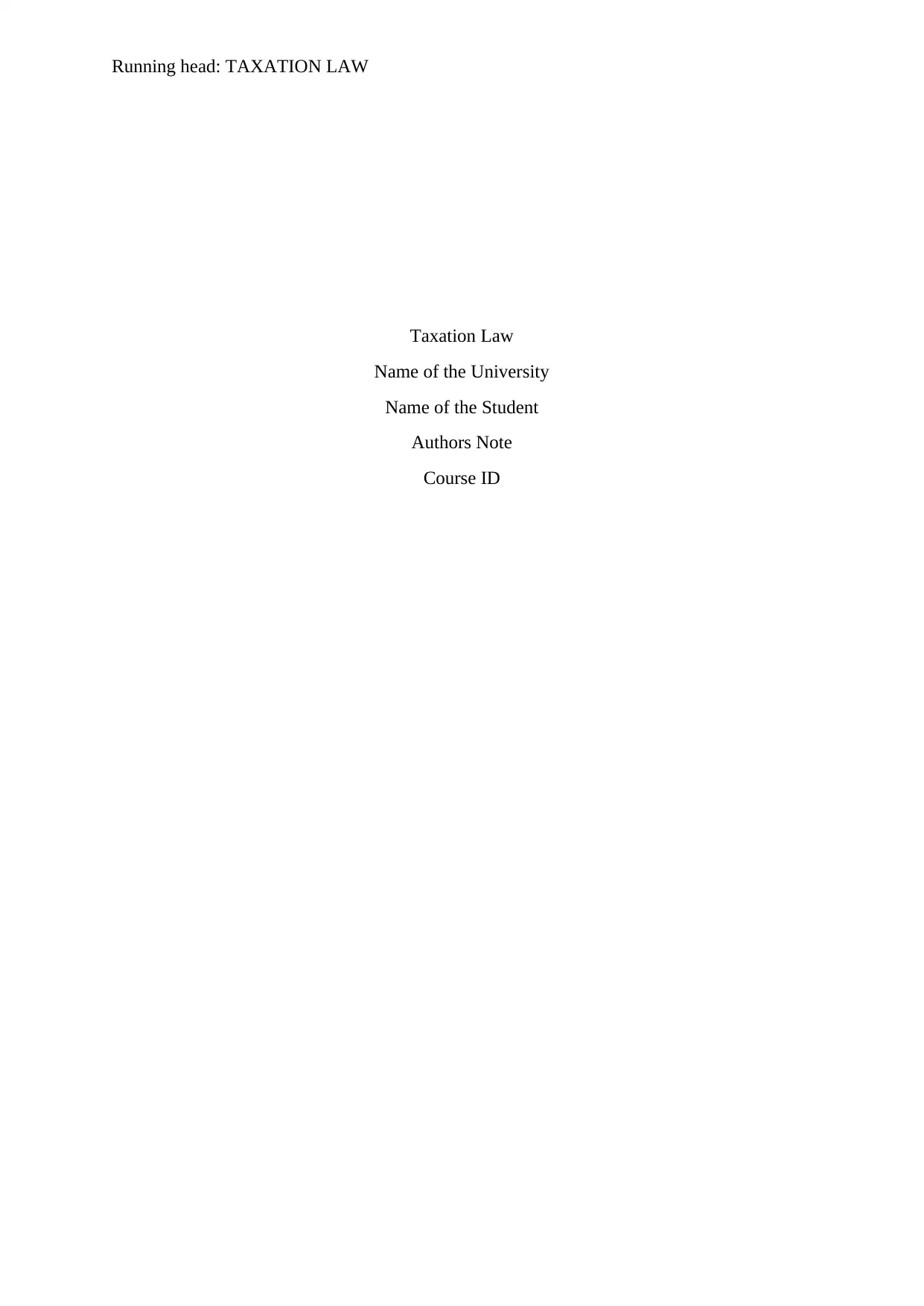
Running head: TAXATION LAW
Taxation Law
Name of the University
Name of the Student
Authors Note
Course ID
Taxation Law
Name of the University
Name of the Student
Authors Note
Course ID
Paraphrase This Document
Need a fresh take? Get an instant paraphrase of this document with our AI Paraphraser
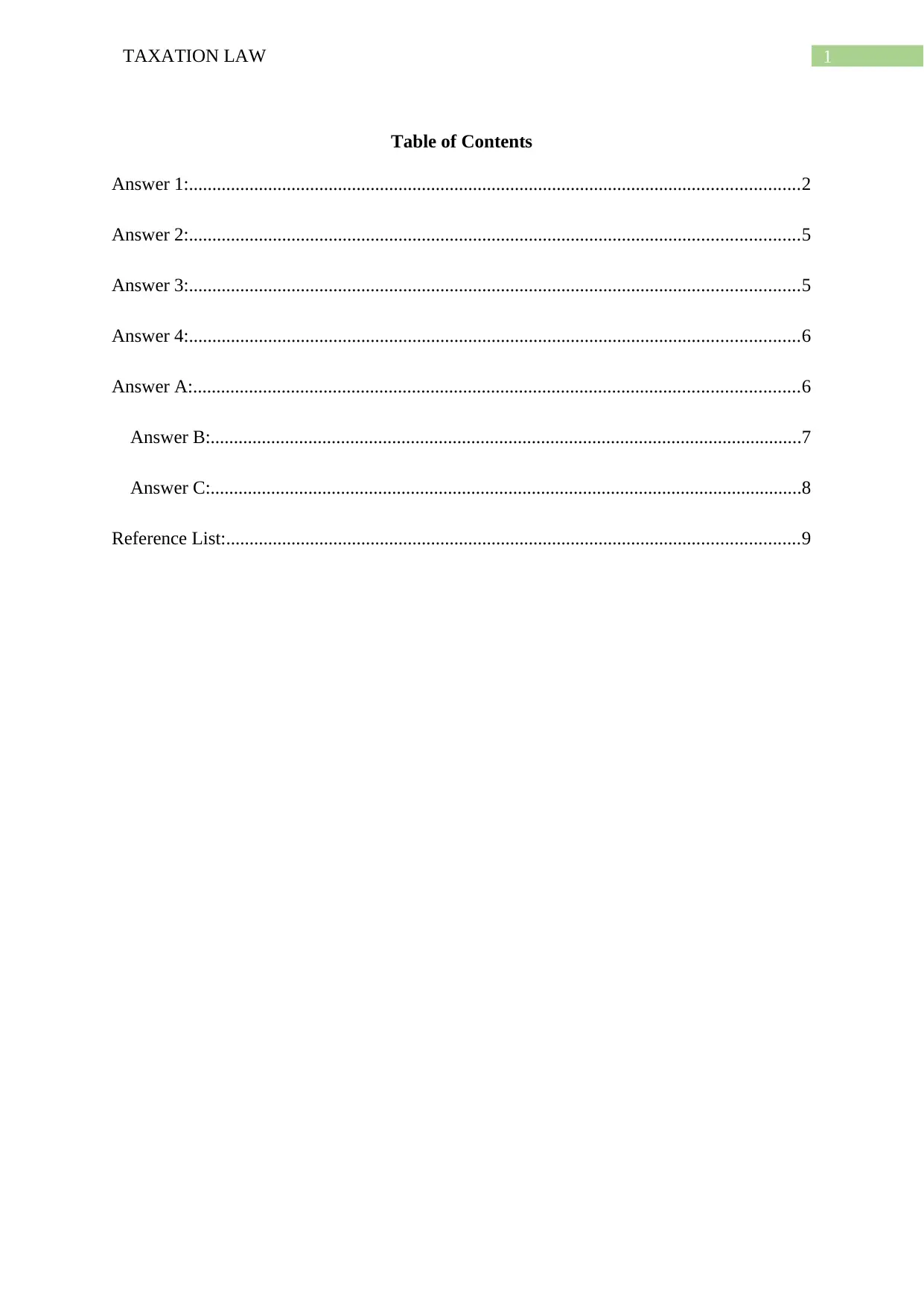
1TAXATION LAW
Table of Contents
Answer 1:...................................................................................................................................2
Answer 2:...................................................................................................................................5
Answer 3:...................................................................................................................................5
Answer 4:...................................................................................................................................6
Answer A:..................................................................................................................................6
Answer B:...............................................................................................................................7
Answer C:...............................................................................................................................8
Reference List:...........................................................................................................................9
Table of Contents
Answer 1:...................................................................................................................................2
Answer 2:...................................................................................................................................5
Answer 3:...................................................................................................................................5
Answer 4:...................................................................................................................................6
Answer A:..................................................................................................................................6
Answer B:...............................................................................................................................7
Answer C:...............................................................................................................................8
Reference List:...........................................................................................................................9
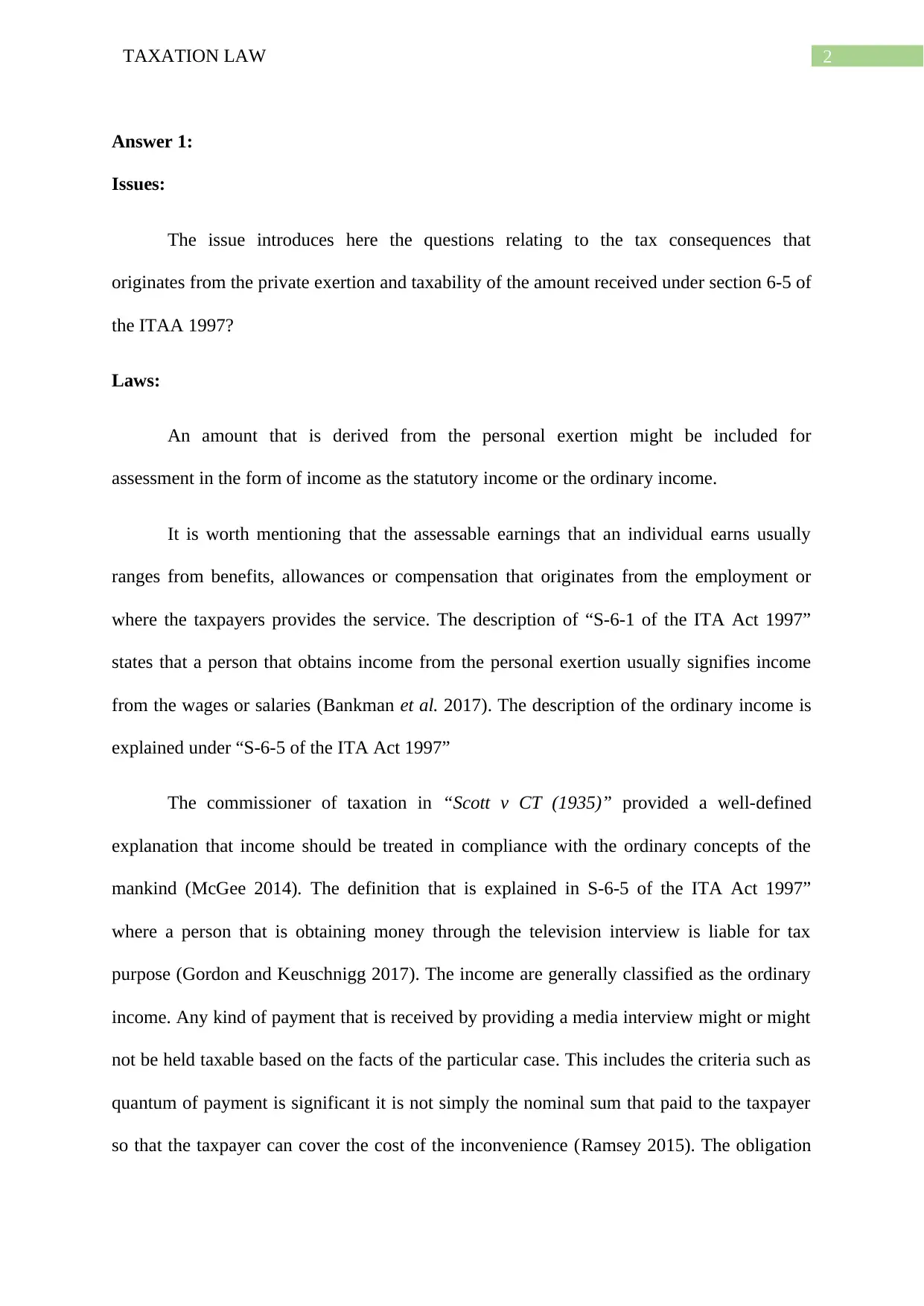
2TAXATION LAW
Answer 1:
Issues:
The issue introduces here the questions relating to the tax consequences that
originates from the private exertion and taxability of the amount received under section 6-5 of
the ITAA 1997?
Laws:
An amount that is derived from the personal exertion might be included for
assessment in the form of income as the statutory income or the ordinary income.
It is worth mentioning that the assessable earnings that an individual earns usually
ranges from benefits, allowances or compensation that originates from the employment or
where the taxpayers provides the service. The description of “S-6-1 of the ITA Act 1997”
states that a person that obtains income from the personal exertion usually signifies income
from the wages or salaries (Bankman et al. 2017). The description of the ordinary income is
explained under “S-6-5 of the ITA Act 1997”
The commissioner of taxation in “Scott v CT (1935)” provided a well-defined
explanation that income should be treated in compliance with the ordinary concepts of the
mankind (McGee 2014). The definition that is explained in S-6-5 of the ITA Act 1997”
where a person that is obtaining money through the television interview is liable for tax
purpose (Gordon and Keuschnigg 2017). The income are generally classified as the ordinary
income. Any kind of payment that is received by providing a media interview might or might
not be held taxable based on the facts of the particular case. This includes the criteria such as
quantum of payment is significant it is not simply the nominal sum that paid to the taxpayer
so that the taxpayer can cover the cost of the inconvenience (Ramsey 2015). The obligation
Answer 1:
Issues:
The issue introduces here the questions relating to the tax consequences that
originates from the private exertion and taxability of the amount received under section 6-5 of
the ITAA 1997?
Laws:
An amount that is derived from the personal exertion might be included for
assessment in the form of income as the statutory income or the ordinary income.
It is worth mentioning that the assessable earnings that an individual earns usually
ranges from benefits, allowances or compensation that originates from the employment or
where the taxpayers provides the service. The description of “S-6-1 of the ITA Act 1997”
states that a person that obtains income from the personal exertion usually signifies income
from the wages or salaries (Bankman et al. 2017). The description of the ordinary income is
explained under “S-6-5 of the ITA Act 1997”
The commissioner of taxation in “Scott v CT (1935)” provided a well-defined
explanation that income should be treated in compliance with the ordinary concepts of the
mankind (McGee 2014). The definition that is explained in S-6-5 of the ITA Act 1997”
where a person that is obtaining money through the television interview is liable for tax
purpose (Gordon and Keuschnigg 2017). The income are generally classified as the ordinary
income. Any kind of payment that is received by providing a media interview might or might
not be held taxable based on the facts of the particular case. This includes the criteria such as
quantum of payment is significant it is not simply the nominal sum that paid to the taxpayer
so that the taxpayer can cover the cost of the inconvenience (Ramsey 2015). The obligation
⊘ This is a preview!⊘
Do you want full access?
Subscribe today to unlock all pages.

Trusted by 1+ million students worldwide
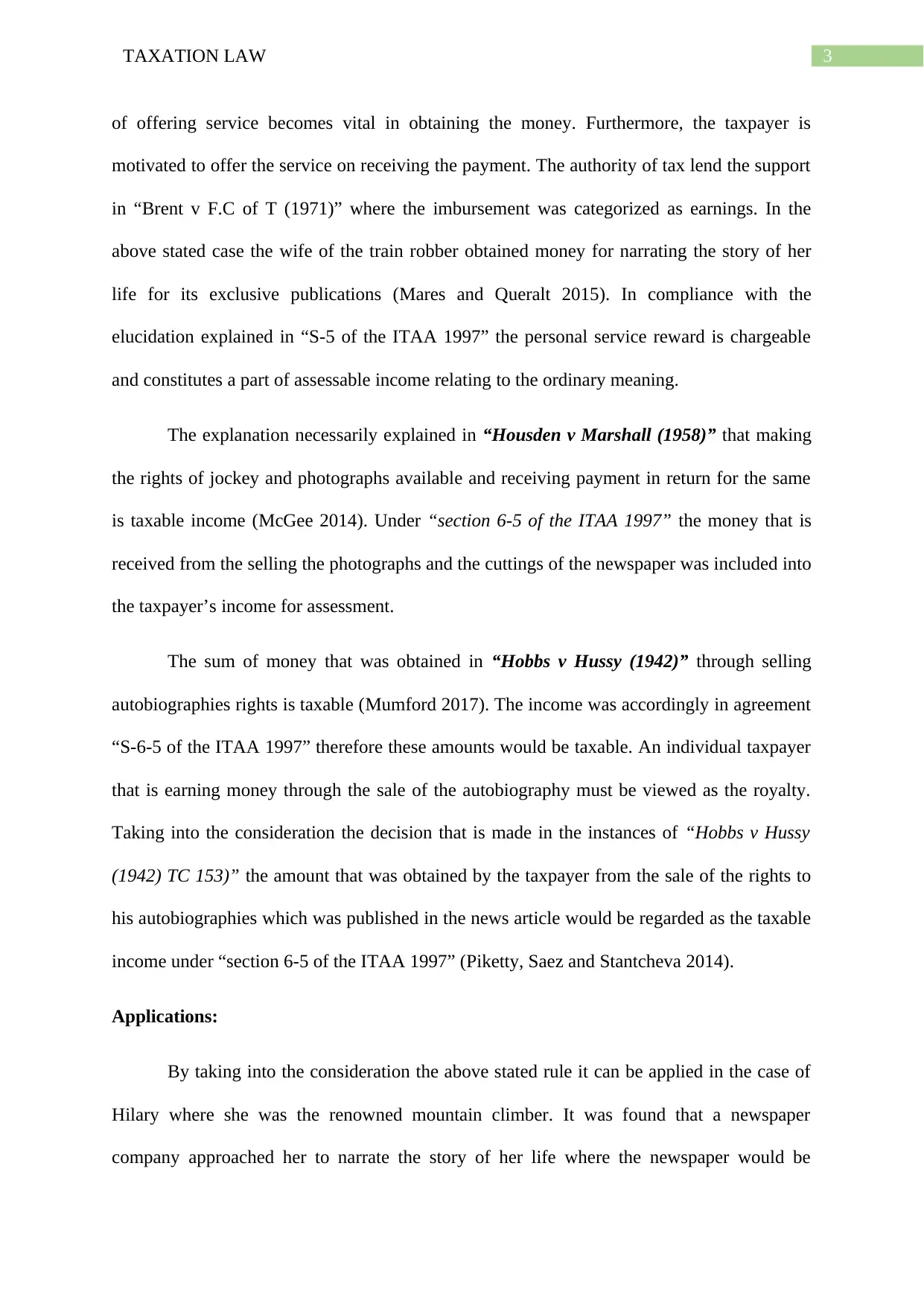
3TAXATION LAW
of offering service becomes vital in obtaining the money. Furthermore, the taxpayer is
motivated to offer the service on receiving the payment. The authority of tax lend the support
in “Brent v F.C of T (1971)” where the imbursement was categorized as earnings. In the
above stated case the wife of the train robber obtained money for narrating the story of her
life for its exclusive publications (Mares and Queralt 2015). In compliance with the
elucidation explained in “S-5 of the ITAA 1997” the personal service reward is chargeable
and constitutes a part of assessable income relating to the ordinary meaning.
The explanation necessarily explained in “Housden v Marshall (1958)” that making
the rights of jockey and photographs available and receiving payment in return for the same
is taxable income (McGee 2014). Under “section 6-5 of the ITAA 1997” the money that is
received from the selling the photographs and the cuttings of the newspaper was included into
the taxpayer’s income for assessment.
The sum of money that was obtained in “Hobbs v Hussy (1942)” through selling
autobiographies rights is taxable (Mumford 2017). The income was accordingly in agreement
“S-6-5 of the ITAA 1997” therefore these amounts would be taxable. An individual taxpayer
that is earning money through the sale of the autobiography must be viewed as the royalty.
Taking into the consideration the decision that is made in the instances of “Hobbs v Hussy
(1942) TC 153)” the amount that was obtained by the taxpayer from the sale of the rights to
his autobiographies which was published in the news article would be regarded as the taxable
income under “section 6-5 of the ITAA 1997” (Piketty, Saez and Stantcheva 2014).
Applications:
By taking into the consideration the above stated rule it can be applied in the case of
Hilary where she was the renowned mountain climber. It was found that a newspaper
company approached her to narrate the story of her life where the newspaper would be
of offering service becomes vital in obtaining the money. Furthermore, the taxpayer is
motivated to offer the service on receiving the payment. The authority of tax lend the support
in “Brent v F.C of T (1971)” where the imbursement was categorized as earnings. In the
above stated case the wife of the train robber obtained money for narrating the story of her
life for its exclusive publications (Mares and Queralt 2015). In compliance with the
elucidation explained in “S-5 of the ITAA 1997” the personal service reward is chargeable
and constitutes a part of assessable income relating to the ordinary meaning.
The explanation necessarily explained in “Housden v Marshall (1958)” that making
the rights of jockey and photographs available and receiving payment in return for the same
is taxable income (McGee 2014). Under “section 6-5 of the ITAA 1997” the money that is
received from the selling the photographs and the cuttings of the newspaper was included into
the taxpayer’s income for assessment.
The sum of money that was obtained in “Hobbs v Hussy (1942)” through selling
autobiographies rights is taxable (Mumford 2017). The income was accordingly in agreement
“S-6-5 of the ITAA 1997” therefore these amounts would be taxable. An individual taxpayer
that is earning money through the sale of the autobiography must be viewed as the royalty.
Taking into the consideration the decision that is made in the instances of “Hobbs v Hussy
(1942) TC 153)” the amount that was obtained by the taxpayer from the sale of the rights to
his autobiographies which was published in the news article would be regarded as the taxable
income under “section 6-5 of the ITAA 1997” (Piketty, Saez and Stantcheva 2014).
Applications:
By taking into the consideration the above stated rule it can be applied in the case of
Hilary where she was the renowned mountain climber. It was found that a newspaper
company approached her to narrate the story of her life where the newspaper would be
Paraphrase This Document
Need a fresh take? Get an instant paraphrase of this document with our AI Paraphraser
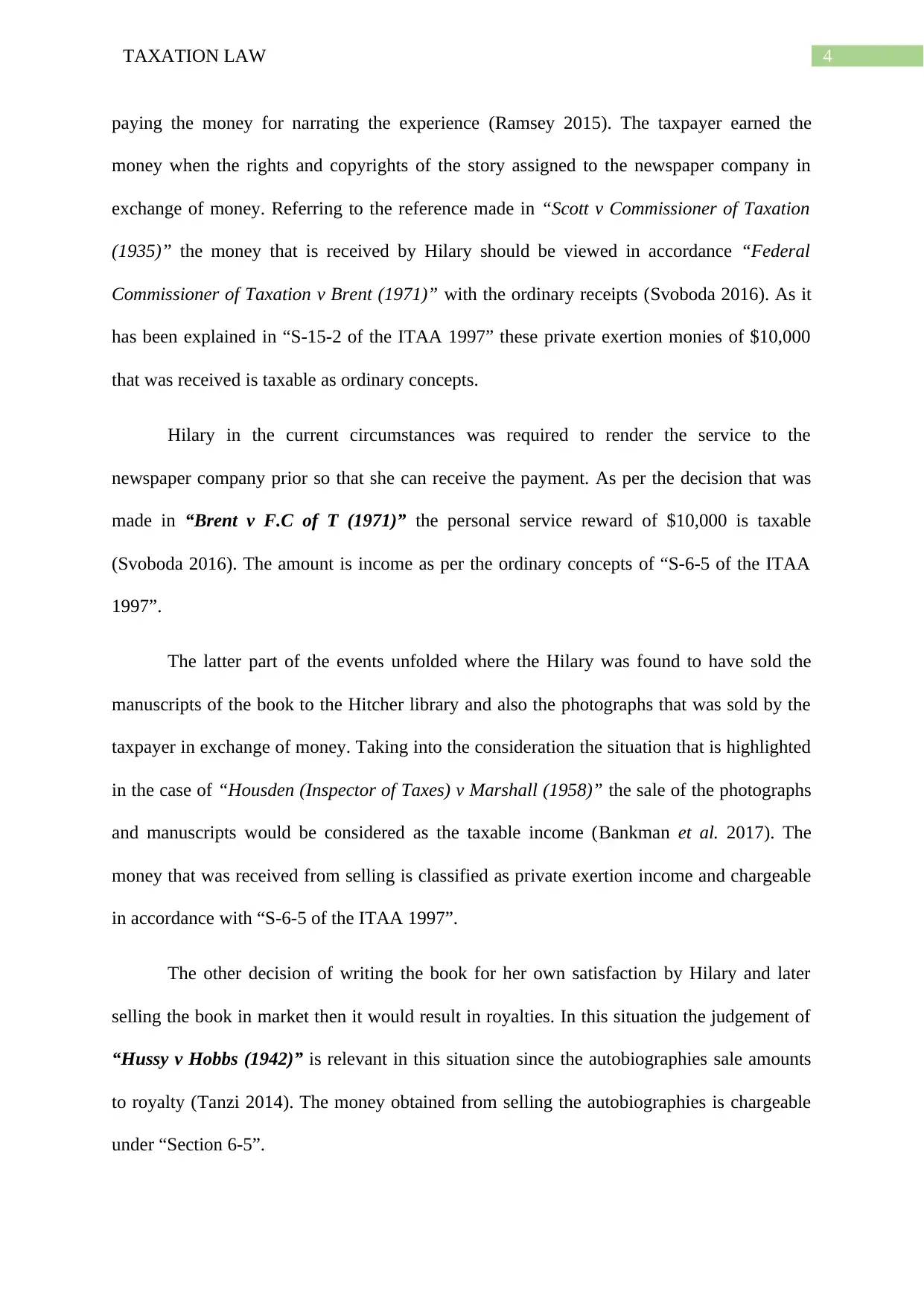
4TAXATION LAW
paying the money for narrating the experience (Ramsey 2015). The taxpayer earned the
money when the rights and copyrights of the story assigned to the newspaper company in
exchange of money. Referring to the reference made in “Scott v Commissioner of Taxation
(1935)” the money that is received by Hilary should be viewed in accordance “Federal
Commissioner of Taxation v Brent (1971)” with the ordinary receipts (Svoboda 2016). As it
has been explained in “S-15-2 of the ITAA 1997” these private exertion monies of $10,000
that was received is taxable as ordinary concepts.
Hilary in the current circumstances was required to render the service to the
newspaper company prior so that she can receive the payment. As per the decision that was
made in “Brent v F.C of T (1971)” the personal service reward of $10,000 is taxable
(Svoboda 2016). The amount is income as per the ordinary concepts of “S-6-5 of the ITAA
1997”.
The latter part of the events unfolded where the Hilary was found to have sold the
manuscripts of the book to the Hitcher library and also the photographs that was sold by the
taxpayer in exchange of money. Taking into the consideration the situation that is highlighted
in the case of “Housden (Inspector of Taxes) v Marshall (1958)” the sale of the photographs
and manuscripts would be considered as the taxable income (Bankman et al. 2017). The
money that was received from selling is classified as private exertion income and chargeable
in accordance with “S-6-5 of the ITAA 1997”.
The other decision of writing the book for her own satisfaction by Hilary and later
selling the book in market then it would result in royalties. In this situation the judgement of
“Hussy v Hobbs (1942)” is relevant in this situation since the autobiographies sale amounts
to royalty (Tanzi 2014). The money obtained from selling the autobiographies is chargeable
under “Section 6-5”.
paying the money for narrating the experience (Ramsey 2015). The taxpayer earned the
money when the rights and copyrights of the story assigned to the newspaper company in
exchange of money. Referring to the reference made in “Scott v Commissioner of Taxation
(1935)” the money that is received by Hilary should be viewed in accordance “Federal
Commissioner of Taxation v Brent (1971)” with the ordinary receipts (Svoboda 2016). As it
has been explained in “S-15-2 of the ITAA 1997” these private exertion monies of $10,000
that was received is taxable as ordinary concepts.
Hilary in the current circumstances was required to render the service to the
newspaper company prior so that she can receive the payment. As per the decision that was
made in “Brent v F.C of T (1971)” the personal service reward of $10,000 is taxable
(Svoboda 2016). The amount is income as per the ordinary concepts of “S-6-5 of the ITAA
1997”.
The latter part of the events unfolded where the Hilary was found to have sold the
manuscripts of the book to the Hitcher library and also the photographs that was sold by the
taxpayer in exchange of money. Taking into the consideration the situation that is highlighted
in the case of “Housden (Inspector of Taxes) v Marshall (1958)” the sale of the photographs
and manuscripts would be considered as the taxable income (Bankman et al. 2017). The
money that was received from selling is classified as private exertion income and chargeable
in accordance with “S-6-5 of the ITAA 1997”.
The other decision of writing the book for her own satisfaction by Hilary and later
selling the book in market then it would result in royalties. In this situation the judgement of
“Hussy v Hobbs (1942)” is relevant in this situation since the autobiographies sale amounts
to royalty (Tanzi 2014). The money obtained from selling the autobiographies is chargeable
under “Section 6-5”.
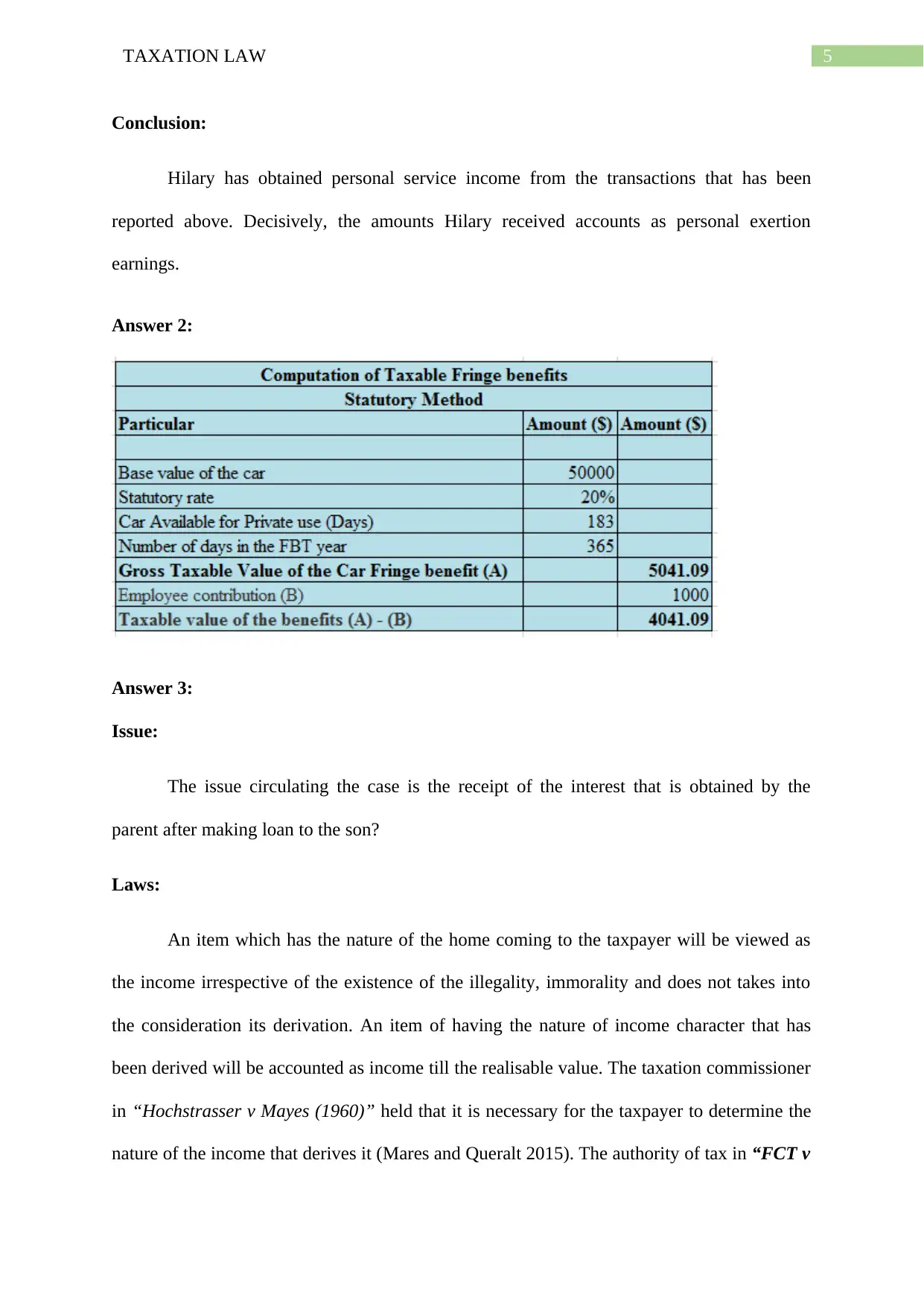
5TAXATION LAW
Conclusion:
Hilary has obtained personal service income from the transactions that has been
reported above. Decisively, the amounts Hilary received accounts as personal exertion
earnings.
Answer 2:
Answer 3:
Issue:
The issue circulating the case is the receipt of the interest that is obtained by the
parent after making loan to the son?
Laws:
An item which has the nature of the home coming to the taxpayer will be viewed as
the income irrespective of the existence of the illegality, immorality and does not takes into
the consideration its derivation. An item of having the nature of income character that has
been derived will be accounted as income till the realisable value. The taxation commissioner
in “Hochstrasser v Mayes (1960)” held that it is necessary for the taxpayer to determine the
nature of the income that derives it (Mares and Queralt 2015). The authority of tax in “FCT v
Conclusion:
Hilary has obtained personal service income from the transactions that has been
reported above. Decisively, the amounts Hilary received accounts as personal exertion
earnings.
Answer 2:
Answer 3:
Issue:
The issue circulating the case is the receipt of the interest that is obtained by the
parent after making loan to the son?
Laws:
An item which has the nature of the home coming to the taxpayer will be viewed as
the income irrespective of the existence of the illegality, immorality and does not takes into
the consideration its derivation. An item of having the nature of income character that has
been derived will be accounted as income till the realisable value. The taxation commissioner
in “Hochstrasser v Mayes (1960)” held that it is necessary for the taxpayer to determine the
nature of the income that derives it (Mares and Queralt 2015). The authority of tax in “FCT v
⊘ This is a preview!⊘
Do you want full access?
Subscribe today to unlock all pages.

Trusted by 1+ million students worldwide
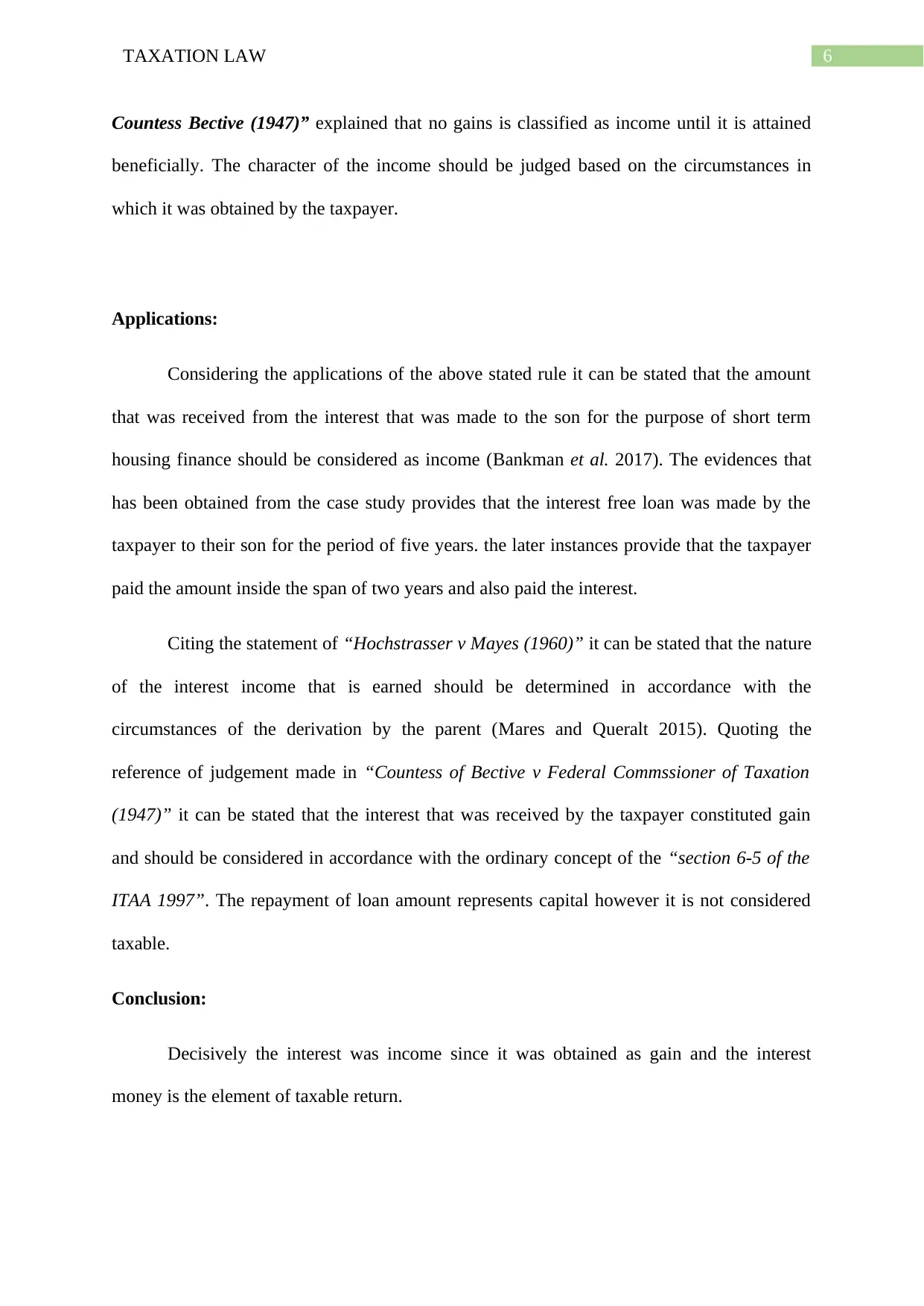
6TAXATION LAW
Countess Bective (1947)” explained that no gains is classified as income until it is attained
beneficially. The character of the income should be judged based on the circumstances in
which it was obtained by the taxpayer.
Applications:
Considering the applications of the above stated rule it can be stated that the amount
that was received from the interest that was made to the son for the purpose of short term
housing finance should be considered as income (Bankman et al. 2017). The evidences that
has been obtained from the case study provides that the interest free loan was made by the
taxpayer to their son for the period of five years. the later instances provide that the taxpayer
paid the amount inside the span of two years and also paid the interest.
Citing the statement of “Hochstrasser v Mayes (1960)” it can be stated that the nature
of the interest income that is earned should be determined in accordance with the
circumstances of the derivation by the parent (Mares and Queralt 2015). Quoting the
reference of judgement made in “Countess of Bective v Federal Commssioner of Taxation
(1947)” it can be stated that the interest that was received by the taxpayer constituted gain
and should be considered in accordance with the ordinary concept of the “section 6-5 of the
ITAA 1997”. The repayment of loan amount represents capital however it is not considered
taxable.
Conclusion:
Decisively the interest was income since it was obtained as gain and the interest
money is the element of taxable return.
Countess Bective (1947)” explained that no gains is classified as income until it is attained
beneficially. The character of the income should be judged based on the circumstances in
which it was obtained by the taxpayer.
Applications:
Considering the applications of the above stated rule it can be stated that the amount
that was received from the interest that was made to the son for the purpose of short term
housing finance should be considered as income (Bankman et al. 2017). The evidences that
has been obtained from the case study provides that the interest free loan was made by the
taxpayer to their son for the period of five years. the later instances provide that the taxpayer
paid the amount inside the span of two years and also paid the interest.
Citing the statement of “Hochstrasser v Mayes (1960)” it can be stated that the nature
of the interest income that is earned should be determined in accordance with the
circumstances of the derivation by the parent (Mares and Queralt 2015). Quoting the
reference of judgement made in “Countess of Bective v Federal Commssioner of Taxation
(1947)” it can be stated that the interest that was received by the taxpayer constituted gain
and should be considered in accordance with the ordinary concept of the “section 6-5 of the
ITAA 1997”. The repayment of loan amount represents capital however it is not considered
taxable.
Conclusion:
Decisively the interest was income since it was obtained as gain and the interest
money is the element of taxable return.
Paraphrase This Document
Need a fresh take? Get an instant paraphrase of this document with our AI Paraphraser
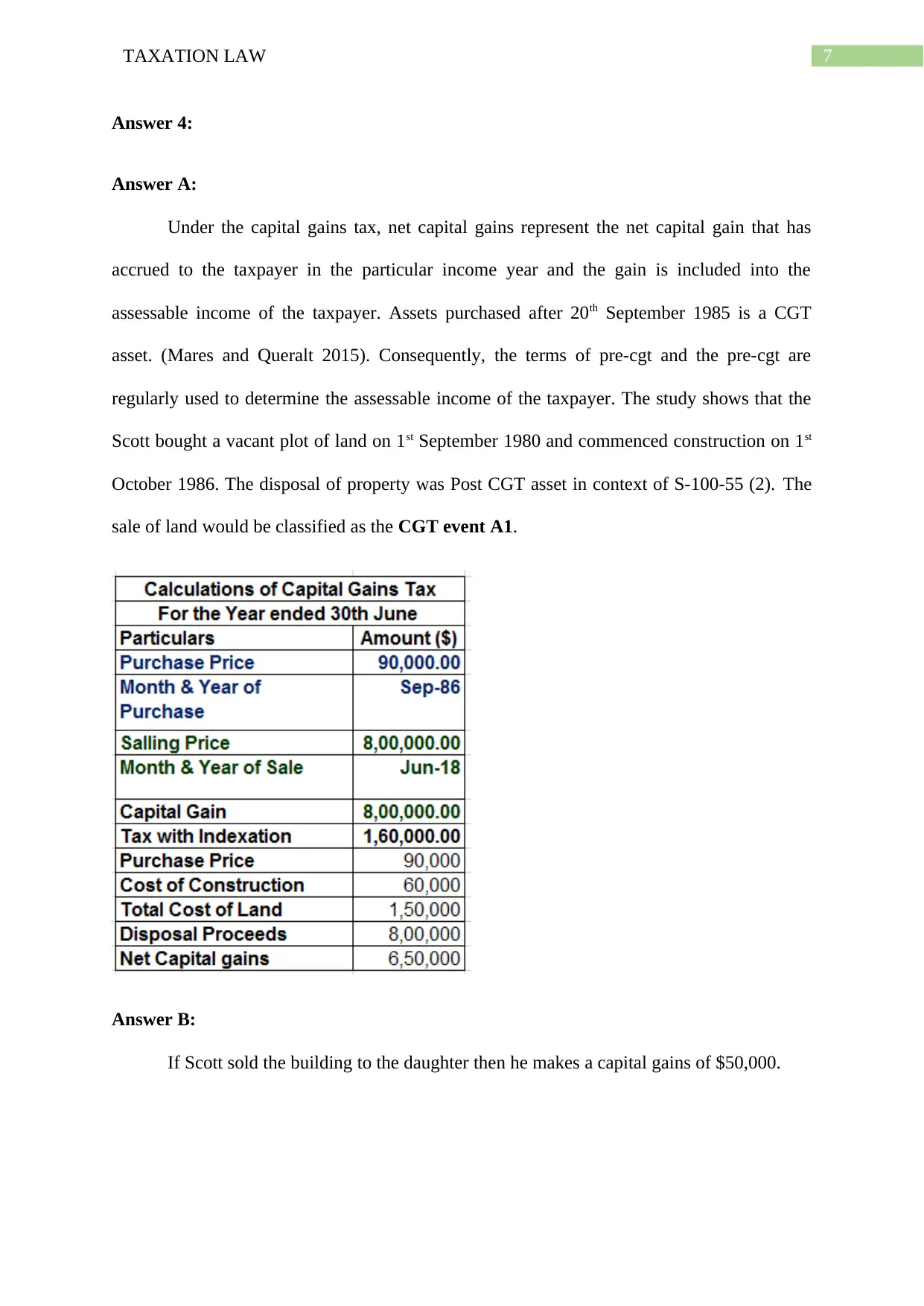
7TAXATION LAW
Answer 4:
Answer A:
Under the capital gains tax, net capital gains represent the net capital gain that has
accrued to the taxpayer in the particular income year and the gain is included into the
assessable income of the taxpayer. Assets purchased after 20th September 1985 is a CGT
asset. (Mares and Queralt 2015). Consequently, the terms of pre-cgt and the pre-cgt are
regularly used to determine the assessable income of the taxpayer. The study shows that the
Scott bought a vacant plot of land on 1st September 1980 and commenced construction on 1st
October 1986. The disposal of property was Post CGT asset in context of S-100-55 (2). The
sale of land would be classified as the CGT event A1.
Answer B:
If Scott sold the building to the daughter then he makes a capital gains of $50,000.
Answer 4:
Answer A:
Under the capital gains tax, net capital gains represent the net capital gain that has
accrued to the taxpayer in the particular income year and the gain is included into the
assessable income of the taxpayer. Assets purchased after 20th September 1985 is a CGT
asset. (Mares and Queralt 2015). Consequently, the terms of pre-cgt and the pre-cgt are
regularly used to determine the assessable income of the taxpayer. The study shows that the
Scott bought a vacant plot of land on 1st September 1980 and commenced construction on 1st
October 1986. The disposal of property was Post CGT asset in context of S-100-55 (2). The
sale of land would be classified as the CGT event A1.
Answer B:
If Scott sold the building to the daughter then he makes a capital gains of $50,000.
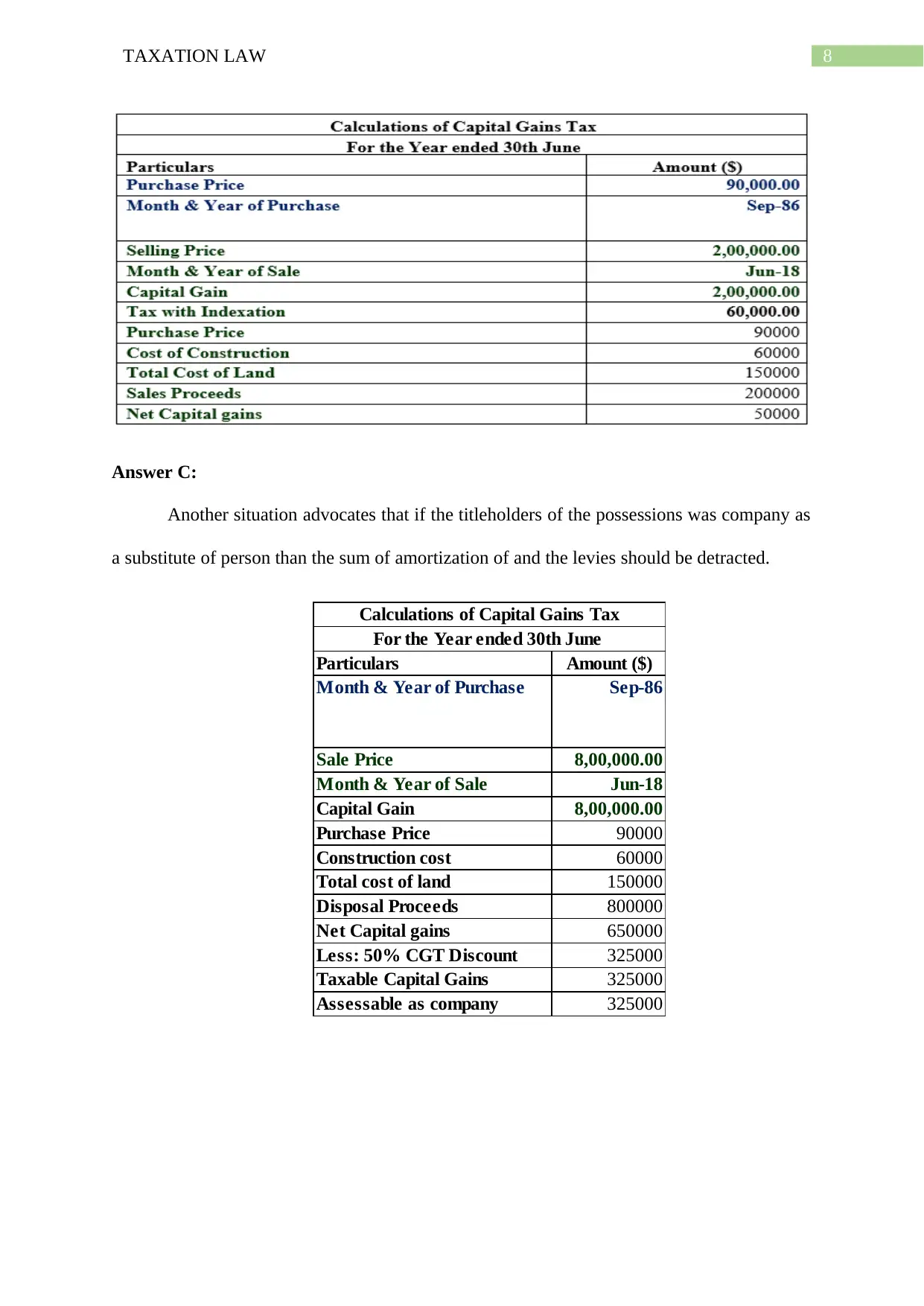
8TAXATION LAW
Answer C:
Another situation advocates that if the titleholders of the possessions was company as
a substitute of person than the sum of amortization of and the levies should be detracted.
Particulars Amount ($)
Month & Year of Purchase Sep-86
Sale Price 8,00,000.00
Month & Year of Sale Jun-18
Capital Gain 8,00,000.00
Purchase Price 90000
Construction cost 60000
Total cost of land 150000
Disposal Proceeds 800000
Net Capital gains 650000
Less: 50% CGT Discount 325000
Taxable Capital Gains 325000
Assessable as company 325000
Calculations of Capital Gains Tax
For the Year ended 30th June
Answer C:
Another situation advocates that if the titleholders of the possessions was company as
a substitute of person than the sum of amortization of and the levies should be detracted.
Particulars Amount ($)
Month & Year of Purchase Sep-86
Sale Price 8,00,000.00
Month & Year of Sale Jun-18
Capital Gain 8,00,000.00
Purchase Price 90000
Construction cost 60000
Total cost of land 150000
Disposal Proceeds 800000
Net Capital gains 650000
Less: 50% CGT Discount 325000
Taxable Capital Gains 325000
Assessable as company 325000
Calculations of Capital Gains Tax
For the Year ended 30th June
⊘ This is a preview!⊘
Do you want full access?
Subscribe today to unlock all pages.

Trusted by 1+ million students worldwide
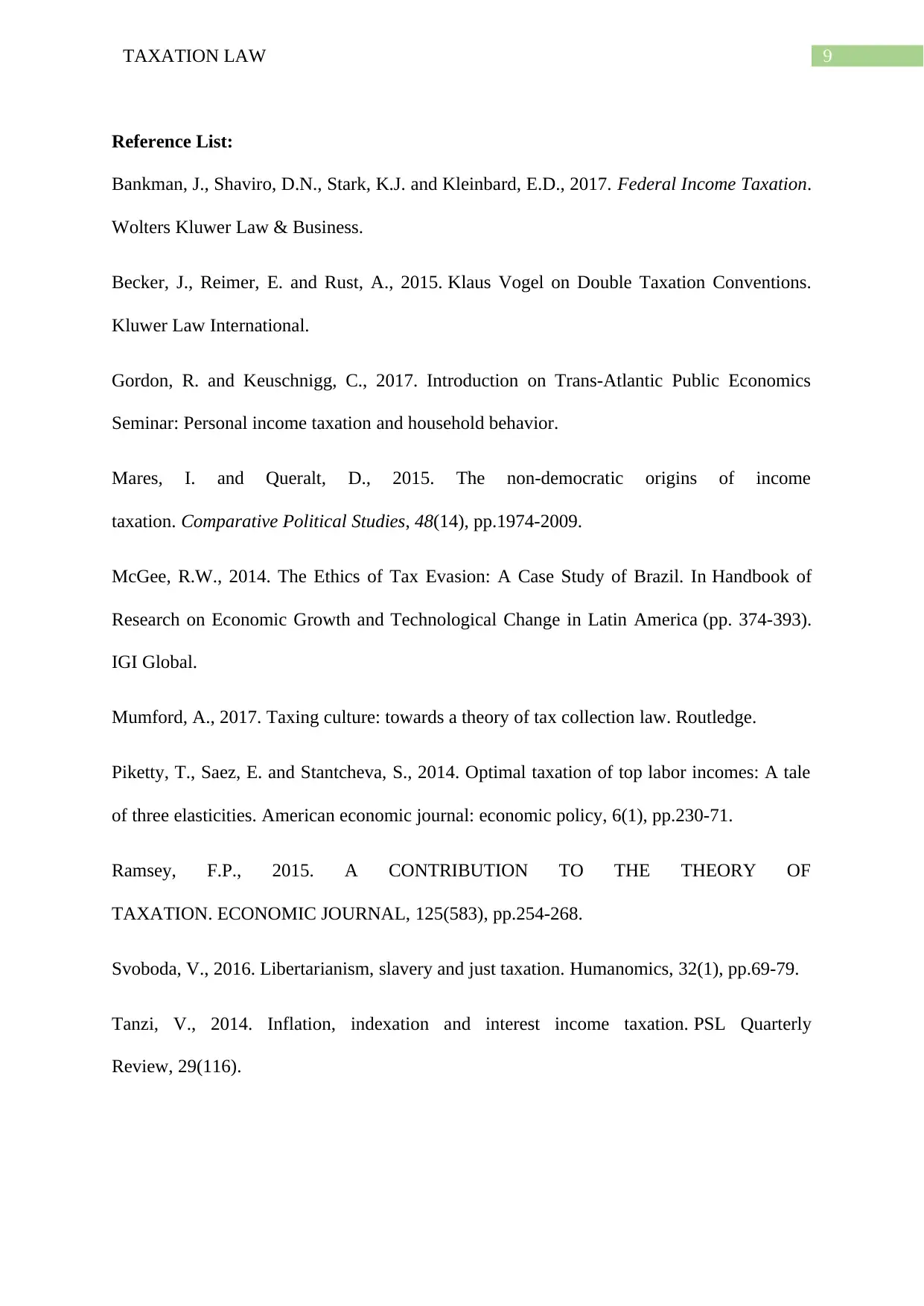
9TAXATION LAW
Reference List:
Bankman, J., Shaviro, D.N., Stark, K.J. and Kleinbard, E.D., 2017. Federal Income Taxation.
Wolters Kluwer Law & Business.
Becker, J., Reimer, E. and Rust, A., 2015. Klaus Vogel on Double Taxation Conventions.
Kluwer Law International.
Gordon, R. and Keuschnigg, C., 2017. Introduction on Trans-Atlantic Public Economics
Seminar: Personal income taxation and household behavior.
Mares, I. and Queralt, D., 2015. The non-democratic origins of income
taxation. Comparative Political Studies, 48(14), pp.1974-2009.
McGee, R.W., 2014. The Ethics of Tax Evasion: A Case Study of Brazil. In Handbook of
Research on Economic Growth and Technological Change in Latin America (pp. 374-393).
IGI Global.
Mumford, A., 2017. Taxing culture: towards a theory of tax collection law. Routledge.
Piketty, T., Saez, E. and Stantcheva, S., 2014. Optimal taxation of top labor incomes: A tale
of three elasticities. American economic journal: economic policy, 6(1), pp.230-71.
Ramsey, F.P., 2015. A CONTRIBUTION TO THE THEORY OF
TAXATION. ECONOMIC JOURNAL, 125(583), pp.254-268.
Svoboda, V., 2016. Libertarianism, slavery and just taxation. Humanomics, 32(1), pp.69-79.
Tanzi, V., 2014. Inflation, indexation and interest income taxation. PSL Quarterly
Review, 29(116).
Reference List:
Bankman, J., Shaviro, D.N., Stark, K.J. and Kleinbard, E.D., 2017. Federal Income Taxation.
Wolters Kluwer Law & Business.
Becker, J., Reimer, E. and Rust, A., 2015. Klaus Vogel on Double Taxation Conventions.
Kluwer Law International.
Gordon, R. and Keuschnigg, C., 2017. Introduction on Trans-Atlantic Public Economics
Seminar: Personal income taxation and household behavior.
Mares, I. and Queralt, D., 2015. The non-democratic origins of income
taxation. Comparative Political Studies, 48(14), pp.1974-2009.
McGee, R.W., 2014. The Ethics of Tax Evasion: A Case Study of Brazil. In Handbook of
Research on Economic Growth and Technological Change in Latin America (pp. 374-393).
IGI Global.
Mumford, A., 2017. Taxing culture: towards a theory of tax collection law. Routledge.
Piketty, T., Saez, E. and Stantcheva, S., 2014. Optimal taxation of top labor incomes: A tale
of three elasticities. American economic journal: economic policy, 6(1), pp.230-71.
Ramsey, F.P., 2015. A CONTRIBUTION TO THE THEORY OF
TAXATION. ECONOMIC JOURNAL, 125(583), pp.254-268.
Svoboda, V., 2016. Libertarianism, slavery and just taxation. Humanomics, 32(1), pp.69-79.
Tanzi, V., 2014. Inflation, indexation and interest income taxation. PSL Quarterly
Review, 29(116).
1 out of 10
Related Documents
Your All-in-One AI-Powered Toolkit for Academic Success.
+13062052269
info@desklib.com
Available 24*7 on WhatsApp / Email
![[object Object]](/_next/static/media/star-bottom.7253800d.svg)
Unlock your academic potential
Copyright © 2020–2025 A2Z Services. All Rights Reserved. Developed and managed by ZUCOL.





